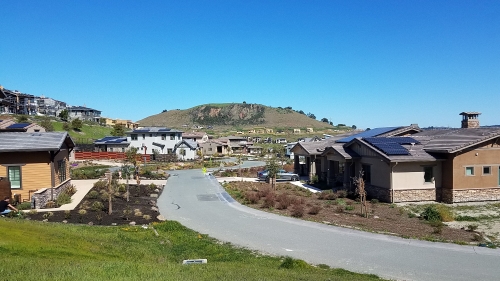We have not been very successful at reducing the number of single-occupancy vehicles. Both San Mateo and Santa Clara counties have had 65%–75% single-occupancy commuters over the last forty years, with little change.
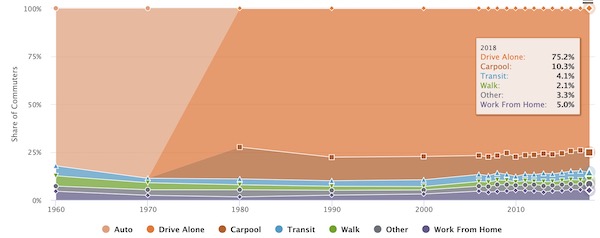
The percentage of people in Santa Clara County that commute to work in a single-occupancy vehicle (light orange) hasn’t changed much since 1980 (pre-pandemic). San Mateo County looks similar, but with slightly more transit. Data through 2018 only. Source: Metropolitan Transportation Commission
The pandemic has kept us off of the roads -- a plus! -- but also off of transit -- a minus! Telecommuting will stick around to some degree, but transit was on a downward trend even before the pandemic. Cars are more appealing now than ever.
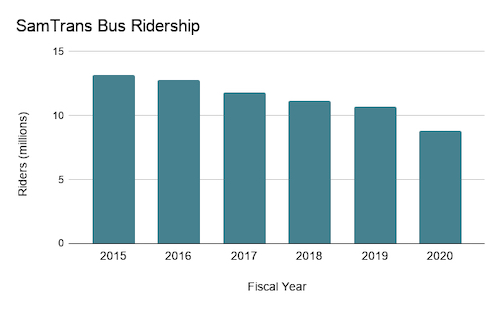
SamTrans ridership has been decreasing for years. Source: SamTrans. VTA has seen similar.
With the pandemic beginning to fade and businesses opening up, our highways are getting busy once again. I would guess most will be at pre-pandemic levels by fall. So it’s time to think again about how to reduce the number of vehicles we have on our roads.
HOV lanes aren’t enough
We know that adding lanes leads to more people driving, an effect called “induced demand”. (1) So we rolled out HOV lanes (“High Occupancy Vehicle” lanes) to encourage carpooling and transit. When they move faster than other lanes they reward people in buses and carpools. Unfortunately, HOV lanes have been slowing down. According to the new SPUR report Freeways of the Future, based on pre-pandemic data, “Of the region’s roughly 450 miles of HOV lanes, more than 50% are ‘very degraded,’ meaning that the average speed is below 45 mph for more than half of the operating hours. In many cases, HOV lanes routinely slow to a near standstill during peak hours.”
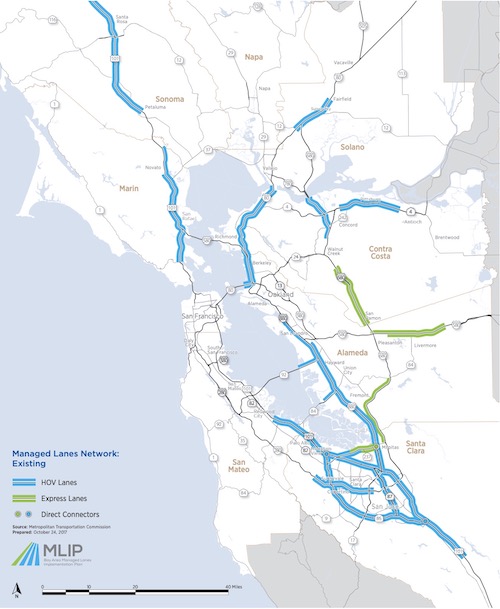
HOV lanes (in blue) throughout the Bay Area, plus a few (tolled) express lanes (in green), as of 2017. Source: SPUR’s Freeways of the Future
Why is this? Part of the problem is that we have more EVs now, which are allowed in the HOV lanes. But a bigger problem is cheating. SPUR cites data from the area’s Metropolitan Transportation Committee (MTC) showing that there are many HOV lane violators, an average of 19% of HOV traffic in the morning peak and 25% in the afternoon peak, and up to 39% on some segments. Better HOV enforcement can help speed up the HOV lanes, offering better reliability for vehicles using those lanes.
But even if there were no cheating, the carpool lanes are not designed to move traffic efficiently. The 2-person or 3-person limit means they will often be too empty or too full. This is where the dynamic pricing used in express lanes comes in. By charging more when lanes are more crowded, lanes can be kept flowing at 45 mph. By charging less when lanes are less crowded, the lanes do not stand empty.
Express lanes are a step up on HOV lanes. They provide better value for transit and carpools, because the traffic keeps moving. They raise revenue that can be used to fund alternative transportation. They provide an express option for drivers that need it. And they reduce pollution and greenhouse gas emissions from our highways.
Express lanes are coming to the Peninsula
Express lanes, sometimes called “High Occupancy Toll lanes” or “HOT lanes”, are coming soon to 101 on the Peninsula. Later this year you will see an 8-mile stretch from just south of Mathilda to the San Mateo County border. 85 will have another 2-3 miles, from the 237 intersection up to 101. See the green segments in the map below.
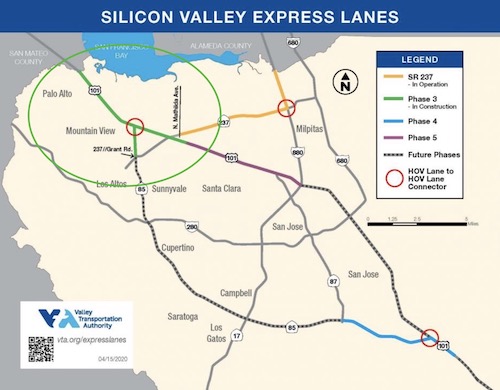
Later this year express lanes will stretch from south of 237 to the San Mateo County line, along with a short stretch on 85 near 101. Source: Valley Transportation Authority
Toward the end of 2022, express lanes will stretch another 22 miles on 101 through San Mateo County to I-380.
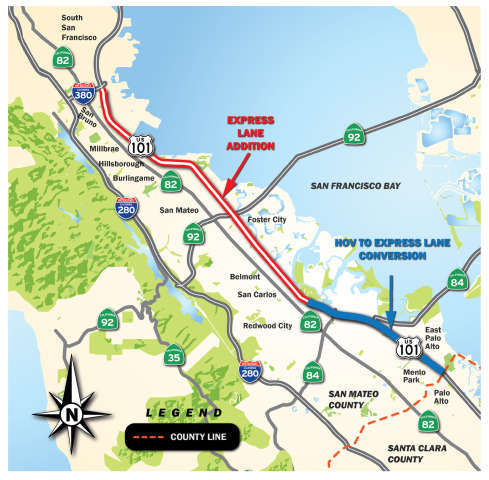
Express lanes along 101 in San Mateo County will go live in fall of 2022. Source: Caltrans
These lanes will charge drivers a fee from 5am to 8pm, with higher costs during more congested times. Fee details are being worked out. For example, while buses and 3-person carpools will travel free, it’s not decided what discount 2-person carpools and/or EVs will get, or what mitigations will be available for low-income drivers. You can get a sense of likely policies by looking at how existing Bay Area express lanes operate. (There is also a good overview of our express lanes here.)

Source: Metropolitan Transportation Commission
You can imagine such policies eventually being extended to all lanes of the highway, based on the principle that the best way to make sure our roads are used efficiently is to charge for them. I think this makes a lot of sense. We should be charging for road use. I grew up on the east coast where tolled highways were the norm. Our express lanes offer more targeted and policy-aligned tolling, and are more robust than the regressive and increasingly irrelevant gas tax. (2)
Is it fair to charge us to drive?
But as much as it seems really sensible to do this, it also seems unfair. Some people object to being charged for something that has always been free. “They’re taking away something that belongs to us.” was how one person put it in a Nextdoor thread started by Palo Alto Online blogger Max Greenberg. Even worse is it seems we are giving yet another advantage to the wealthy. “We risk creating two classes of drivers based on income.” said another person. Or, more pointedly, “As with 880, people without financial limitations zip by in the toll lane, while the remaining 3 lanes are gridlocked from Union City to Oakland. One more step in accommodating the accommodated.” Despite this, organizations like TransForm and SPUR strongly advocate for pricing these lanes and believe that we can (and should) price them equitably. How is that?
One point they make is that today’s policy of free driving is actually quite unfair. Drivers are not paying their fair share, and lower-income households suffer more of the consequences. To be clear, there are many things that drivers do pay extra for. We pay for the car and insurance. We pay (traditionally) for gas, including gas taxes that support our roads. (EVs in California now pay an additional $100-$200 in registration fees.) We pay bridge tolls. We pay (sometimes) for parking. But it’s not enough. The costs of driving go beyond the roads and parking lots that we use. Driving causes air pollution, which causes health problems for those living near traffic. Vehicles emit greenhouse gases, leading to many impacts from global warming. Driving causes noise pollution and tire pollution. It also causes us to reserve increasing amounts of public and private space for roads and parking that could be used for other things. These costs are borne by everyone, whether or not they drive, and are disproportionately borne by lower-income households living near freeways or distribution centers, and in congested areas.
You can think of tolled roads as fixing the way that we pay for driving, to better cover the costs and to do it more accurately (per-mile) and more flexibly (dynamic, targeted pricing). Discounts can be given to lower-income households to reduce the short-term increase in costs, similarly to how the Clipper START pilot is providing discounts for transit. Revenue from the lanes can be invested in improved transit and biking, rewards for carpooling, and more. (San Mateo County is soliciting feedback on this now.) Families with long commutes and/or inflexible work schedules, who are often lower income, may also see considerable benefit from these faster lanes if the prices are adjusted to be affordable.

Officials say it is hard to estimate how much revenue our lanes will bring in each year, but this table shows some examples from around the country. (Source: SPUR’s Freeways of the Future)
In general, tolled lanes can help ensure everyone pays their fair share, make better use of our highways, reduce pollution and greenhouse gas emissions from transportation, and over time help us transition some of our car-allocated space to other uses.
Better bus service must come next
One of the best features of express lanes is that they enable fast and reliable bus service. Most of the buses we see on 101 today are private commute shuttles. We need to develop a regional network of public express buses. Without this alternative, many people will stick to their cars even when the pandemic is past. TransForm designed a compelling system called ReX (Regional Express), which is sort of like light rail but implemented with buses on highways. They propose stations throughout the bay “near jobs, shopping, medical centers, colleges, and more”, with service every 5 minutes at peak times and every 10 minutes otherwise.
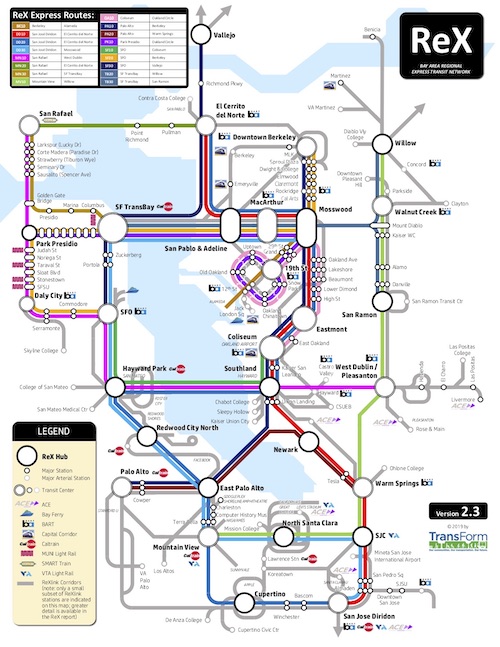
The ReX regional bus system proposed by TransForm. (Source: TransForm)
MTC’s evaluation found that the “costs exceeded the benefits” of this system, but they go on to say that well-run express lanes can help to change that equation. With transit being re-evaluated after the pandemic and substantial federal funding on its way, I hope that some progress can be made on a service like this. If so, we will truly be offering everyone more options, and better options, for getting around the Bay Area than we have today.
I’d love to hear your thoughts, questions, and experiences with express lanes in the Bay Area.
Notes and References
1. The Value Driven report by SPUR cites these two examples: “This (effect of induced demand) has been seen in the widening of the 405 in Los Angeles, which cost more than $1 billion and resulted in slightly slower speeds, and the widening of Houston’s Katy freeway to 23 lanes, which cost $2.8 billion and also resulted in slower travel times for many drivers.”
2. Charging for all the lanes could push traffic onto local streets. California is investigating other ways to implement a mileage tax. One such pilot is described here.
Current Climate Data (February 2021)
Global impacts, US impacts, CO2 metric, Climate dashboard (updated annually)
I want to share an inspiring piece of news, which is that the United Kingdom is now about halfway towards its net-zero emissions target. We can do the same in the coming decade, and I hope we will.
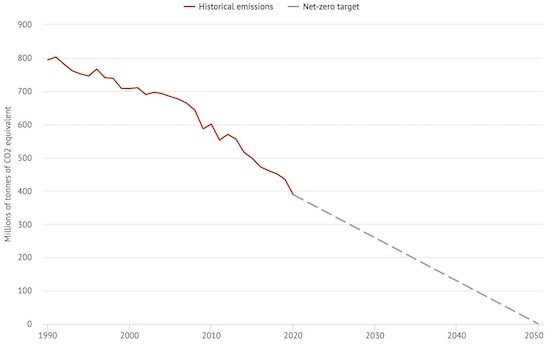
The UK is now about halfway towards its net-zero target. Source: CarbonBrief
Comment Guidelines
I hope that your contributions will be an important part of this blog. To keep the discussion productive, please adhere to these guidelines or your comment may be moderated:
- Avoid disrespectful, disparaging, snide, angry, or ad hominem comments.
- Stay fact-based and refer to reputable sources.
- Stay on topic.
- In general, maintain this as a welcoming space for all readers.





